#batterytechnology
Text


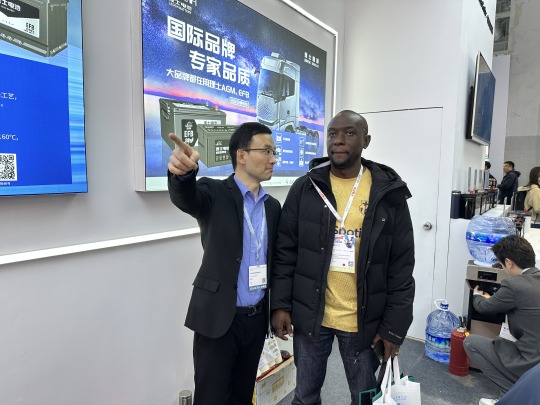
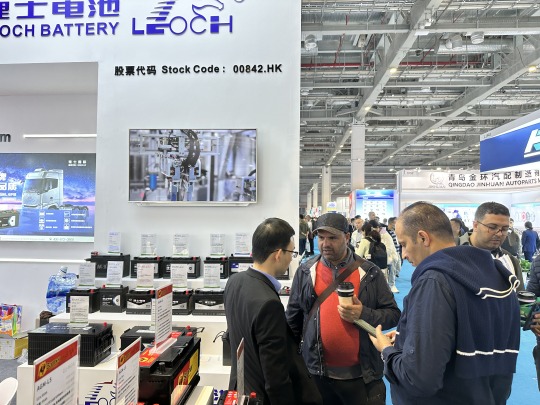
Leoch is the OE supplier for many international automobile manufacturing companies with years of automotive battery experience.
We are confident to be your reliable automotive battery partner! 🤝
Automechanika Shanghai 2023, Leoch is right here! 🚗🔋
#Automobile#CarBattery#Automechanika#EV#StartingBattery#MotiveBattery#AutomechanikaShanghai2023#LeochAutomotiveBatteries#OESupplier#AutomotiveBatteryExperience#ReliablePartner#AutomotiveIndustry#BatteryTechnology#AutomotivePower#BatterySupplier#AutomotiveExcellence
4 notes
·
View notes
Text
The Electric Advantage: Exploring the Benefits of Eco-Friendly Transportation
The Rise of Electric Vehicles: A Sustainable Revolution
Embracing Electric Mobility for a Greener Future
In recent years, the automotive industry has witnessed a profound shift towards sustainable transportation solutions. Among these, electric vehicles (EVs) have emerged as the frontrunners in the quest for eco-friendly mobility. Let's delve into the myriad benefits and advancements driving the surge in electric vehicle adoption.
Sustainable Driving Redefined
Reducing Carbon Footprint with Zero Emissions
One of the primary advantages of electric vehicles is their eco-friendly nature. Unlike traditional gasoline-powered cars, EVs produce zero tailpipe emissions, thereby significantly reducing greenhouse gas emissions and air pollution. By transitioning to electric vehicles, individuals can actively contribute to mitigating climate change and preserving the planet for future generations.
Cutting-edge Technology at the Helm
Innovations Powering Electric Mobility
Electric vehicles are not only environmentally friendly but also synonymous with cutting-edge technology. With advancements in battery technology, EVs boast impressive ranges and rapid charging capabilities, making them practical alternatives for daily commuting and long-distance travel alike. Moreover, features such as regenerative braking and smart connectivity enhance the driving experience while minimizing energy consumption.
Economic Viability and Cost Savings
Driving Towards Financial Efficiency
Contrary to popular belief, the economic viability of electric vehicles extends beyond environmental considerations. Although the initial purchase price of EVs may seem higher than traditional cars, they offer significant long-term cost savings. With lower maintenance requirements and reduced fuel expenses, electric vehicles prove to be more economical over their lifespan, translating into substantial savings for owners.
Infrastructure Expansion Fuels Growth
Expanding Charging Infrastructure for Seamless Mobility
An essential aspect of accelerating the adoption of electric vehicles is the development of robust charging infrastructure. Governments, private companies, and communities worldwide are investing in expanding charging networks, including public charging stations and home charging solutions. This infrastructure expansion not only addresses range anxiety but also promotes the widespread adoption of electric vehicles by offering convenience and accessibility to drivers.
Environmental Benefits Beyond Transportation
A Holistic Approach to Sustainability
The environmental benefits of electric vehicles extend beyond cleaner air and reduced carbon emissions. By integrating renewable energy sources such as solar and wind power with EV charging infrastructure, we can further amplify the environmental advantages of electric mobility. This holistic approach ensures that electric vehicles contribute to a more sustainable and resilient energy ecosystem, paving the way for a cleaner and greener future.
Conclusion: Driving Towards a Sustainable Tomorrow
Embrace the Electric Revolution
As we stand at the precipice of a sustainable transportation revolution, the adoption of electric vehicles represents a pivotal step towards shaping a cleaner, greener future. With technological advancements, cost savings, and environmental benefits driving the transition, electric mobility is poised to redefine the way we commute and interact with our environment. By embracing electric vehicles, we not only embrace innovation but also commit to safeguarding the planet for generations to come.
In conclusion, the rise of electric vehicles heralds a paradigm shift in transportation, offering a compelling vision of sustainability and progress. Let us embark on this journey towards a brighter, cleaner tomorrow, one electric mile at a time.
#ElectricVehicles#EVs#Sustainability#CleanEnergy#ClimateChange#Technology#Innovation#GreenTransportation#RenewableEnergy#ChargingInfrastructure#GovernmentIncentives#FutureMobility#AutonomousDriving#BatteryTechnology#ZeroEmission#CarbonFootprint#EnvironmentalImpact#TransportationRevolution#SmartGrid
0 notes
Link
The electric vehicle (EV) market in India is poised for a surge, with both Hyundai and Kia, sister brands under the Hyundai Motor Group umbrella, gearing up to launch compelling offerings in the compact SUV segment. Kia has unveiled its EV3 globally, while details surrounding the Hyundai Creta EV remain under wraps. However, considering the close ties between the brands and their history of platform sharing, we can speculate on some potential similarities between the two vehicles. Let's delve deeper into this topic, exploring the features the Hyundai Creta EV might borrow from its Kia counterpart. Hyundai Creta EV A Balancing Act: Shared DNA with Individuality Hyundai and Kia are known for creating distinct identities within their shared platforms. While core elements might be similar, they strive to differentiate their vehicles through design choices: Shared Platforms, Distinct Cabins: Unlike some manufacturer partnerships where cabins are nearly identical, Hyundai and Kia prioritize individual design cues. This translates to variations in dashboards, screen layouts, and center consoles while maintaining a sense of underlying similarity. Examples of Differentiation: We've witnessed this approach with the Creta and Seltos, as well as the IONIQ 5 and EV6. The Creta EV is likely to follow suit, featuring a unique cabin theme and subtle design variations around the dashboard. Overall Layout Convergence: Despite individual touches, expect the Creta EV to share fundamental design elements with the EV3. This might include dual integrated screens, a sleek air vent design, a similar sliding center console, and a broadly similar cabin layout. However, the India-spec Creta EV might cater to a slightly less premium market segment compared to the global EV3. Feature Parity: A Focus on Functionality Positioning themselves within the same segment, the Creta EV and EV3 are likely to boast a significant overlap in features: Feature Focus: Both vehicles are expected to offer a comprehensive suite of features, catering to driver and passenger comfort and convenience. While some exclusive features might exist on either side, a significant common ground is anticipated. Predicted Feature List: Drawing from the EV3's feature set, the Creta EV might include dual 12.3-inch displays (infotainment and driver's), touch-controlled automatic climate control with rear AC vents, ambient lighting, cruise control, vehicle-to-load (V2L) capabilities, and a panoramic sunroof. Features like a 12-inch heads-up display might remain exclusive to the EV3. Safety First: Advanced Driver-Assistance Systems (ADAS) The focus on safety is paramount in the automotive industry, and the Creta EV is likely to inherit the EV3's ADAS technology: Level 2 ADAS: The Kia EV3 boasts a Level 2 ADAS system, a suite of features designed to enhance driving safety. Considering the shared ADAS setup between the Creta and Seltos, this technology is a strong candidate for inclusion in the Creta EV. ADAS Features: This system typically incorporates functionalities like forward collision warning, rear collision warning, autonomous emergency braking, lane keep assist, and adaptive cruise control. Additional safety features like airbag count, electronic stability control, 360-degree camera, and front and rear parking sensors are also likely to be carried over from the EV3. Powertrain and Performance: Borrowing for Efficiency? While specific details remain undisclosed, the Creta EV's powertrain and performance might mirror the EV3's setup with some potential tweaks: Battery Pack Options: Globally, the EV3 offers two battery pack choices: a 58.3 kWh unit and a larger 81.4 kWh option. Considering cost constraints in the Indian market, the Creta EV is likely to adopt the smaller battery pack for affordability. Performance Figures: The 58.3 kWh battery pack in the EV3 comes paired with a front-wheel-drive (FWD) setup, potentially offering a WLTP (Worldwide Harmonized Light Vehicles Test Procedures) claimed range exceeding 400 km. The Creta EV might follow suit with this configuration. Motor and Performance Tuning: The EV3's motor delivers 204 PS and 283 Nm, enabling a claimed 0-100 km/h acceleration time of 7.5 seconds and a top speed of 170 km/h. Hyundai might prioritize affordability in the Indian market by offering a slightly detuned version of this powertrain for the Creta EV, potentially leading to a longer overall driving range. FAQs Q: Will the Hyundai Creta EV and Kia EV3 share the same platform? A: While official confirmation is pending, there's a strong possibility that both vehicles will utilize a similar platform due to the shared resources within the Hyundai Motor Group. Q: How will the interiors of the Creta EV and EV3 differ? A: While both might share a similar overall layout, expect the Creta EV to have a distinct cabin theme and potentially slightly different design elements compared to the global EV3. The India-spec Creta EV might cater to a slightly less premium market segment. Q: What features are likely to be common between the Creta EV and EV3? A: Both vehicles are expected to offer a comprehensive suite of features, including dual large displays, a panoramic sunroof, touch-controlled climate control, and advanced driver-assistance systems (ADAS). There might be some feature differentiation, but a significant overlap is likely.
#automotiveindustry#batterytechnology#compactelectricvehicles#electricSUV#electricvehiclefeatures#EVtechnology#HyundaiCretaEV#HyundaiKiapartnership#KiaEV3#vehicleperformance.
0 notes
Text
🔋I am very happy that BSLBATT provides perfect lithium iron phosphate (LiFePo4) solutions for North American customers!
From higher energy density and longer cycle life to faster charging and reduced maintenance, we offer unmatched benefits that can make your business more efficient and productive.
🌎 At BSLBATT we are committed to sustainability. By transitioning from lead-acid to lithium-ion batteries, you not only improve performance but also reduce your environmental impact. Our lithium solutions are cleaner, greener and greener, helping to create a brighter and more sustainable future for all.
🤝 Expert support:
Our team of battery experts is here to support you. From initial assessment and planning to installation and ongoing maintenance, we will work closely with you to ensure a successful transition and maximize the benefits of your new lithium solution.
Ready to switch to LiFePo4 and unleash your battery’s full potential?
Contact now

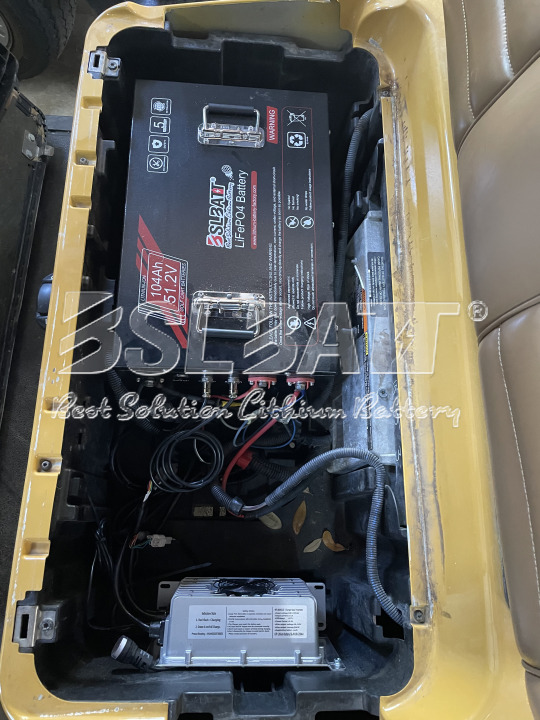

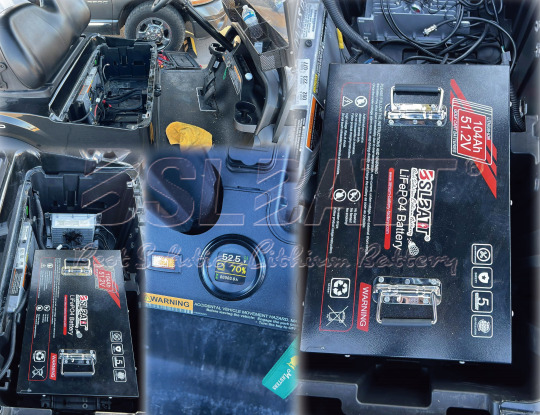
#BSLBATT#LeadToLithium#EnergyStorage#LithiumIon#BatteryTechnology#Sustainability#Performance#NorthAmerica#SeamlessTransition#ExpertSupport#lithiumbattery
0 notes
Text
Motive Lead Acid Battery Market: Trends, Growth Drivers, and Strategic Insights
The U.S. motive lead acid battery market is expected to reach USD 1.57 billion by 2030, according to a new report by Grand View Research, Inc. The market is expected to expand at a CAGR of 3.3% from 2023 to 2030. The demand for lead-acid batteries in the country is majorly driven by their wide application in the automotive industry as a battery backup system for electric vehicles. As electric vehicles are gaining popularity in the U.S. market as a sustainable mode of transportation, the demand for motive lead-acid batteries is anticipated to grow considerably over the forecast period.
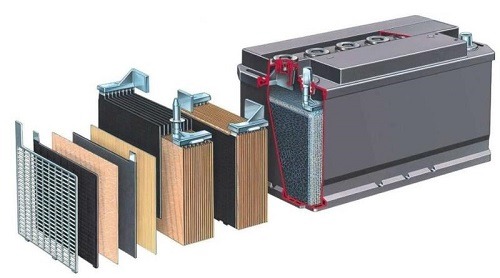
U.S. Motive Lead Acid Battery Market Report Highlights
The market was worth USD 1.19 Billion in 2022 and is projected to grow at a CAGR of 3.3% during the forecast period.
According to the World Wind Energy Association, the U.S. is the world’s second-largest producer of energy and wind and is anticipated to witness substantial growth in the production of energy and wind over the forecast period. In the U.S., the evolution of the energy system is driven by technology innovation, market competition, and state/local policies expressing citizen preference rather than central government planning. This is anticipated to augment the market growth.
The Material handling segment accounted for 25.96% share in 2022 in the market owing to the increasing investment in these equipment and machinery.
Valve Regulated Lead Acid Battery in construction segment is projected to grow at a substantial rate throughout the forecast period.
99.9% Purity (Pure Lead acid) in purity segment accounted for largest share 82.10% share in 2022.
For More Details or Sample Copy please visit link @: U.S. Motive Lead Acid Battery Market Report
Moreover, industrial sector, including chemical, shipping, metal, and mining, is expected to hold a major share of lead-acid battery applications, owing to rapid industrialization. A large manufacturing base of chemical companies and the presence of multinationals, including Bayer AG, BASF SE, Dow, and Akzo Nobel N.V., adopting lead acid batteries as a UPS system are expected to increase industry penetration over the forecast period. The benefits of lithium-ion batteries are a cost-effective and high energy density & better cycle life compared with lead acid batteries. The aforementioned factors make lithium-ion batteries a growing alternative to lead acid batteries, which is anticipated to hinder market growth in the coming years.
The rising demand for ESS is expected to fuel product demand over the forecast period. ESS utilizes batteries considering its advantages such as recyclability, high power delivery, and cost-effectiveness. Lead acid batteries are the most-used battery types for ESS due to applications such as battery systems, emergency power supply systems, and stand-alone systems with PV for mitigating output fluctuations from solar and wind power. Furthermore, lead acid batteries are lower in cost compared to alternatives and are expected to witness industry growth in the coming years.
#LeadAcidBattery#MotiveBattery#BatteryMarket#EnergyStorage#IndustrialBatteries#ElectricVehicles#BatteryTechnology#RenewableEnergy#SustainableEnergy#PowerSolutions#AutomotiveBattery#BatteryInnovation#EnergyEfficiency#GreenEnergy#BatteryIndustry#BatteryManufacturing#EnergyStorageSolutions
0 notes
Text
3D Printed Batteries Market is Dazzling Worldwide and Forecast to 2030 | GQ Research
The 3D Printed Batteries market is set to witness remarkable growth, as indicated by recent market analysis conducted by GQ Research. In 2023, the global 3D Printed Batteries market showcased a significant presence, boasting a valuation of USD 120.50 Million. This underscores the substantial demand for 3D Printed Batteries technology and its widespread adoption across various industries.
Get Sample of this Report at: https://gqresearch.com/request-sample/global-3d-printed-batteries-market/
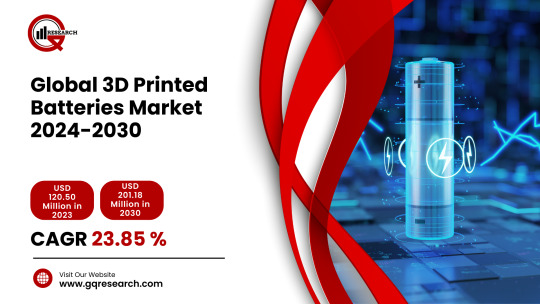
Projected Growth: Projections suggest that the 3D Printed Batteries market will continue its upward trajectory, with a projected value of USD 201.18 Million by 2030. This growth is expected to be driven by technological advancements, increasing consumer demand, and expanding application areas.
Compound Annual Growth Rate (CAGR): The forecast period anticipates a Compound Annual Growth Rate (CAGR) of 23.85 %, reflecting a steady and robust growth rate for the 3D Printed Batteries market over the coming years.
Technology Adoption:
The adoption of 3D printed batteries represents a significant leap forward in energy storage technology, offering unparalleled flexibility, customization, and efficiency. With the ability to fabricate intricate battery designs layer by layer, 3D printing revolutionizes the production process, enabling the creation of batteries with complex geometries and tailored properties. This technology finds applications across various industries, including electronics, automotive, aerospace, and renewable energy, where the demand for compact, lightweight, and high-performance energy storage solutions is paramount.
Application Diversity:
The application diversity of 3D printed batteries spans a wide range of industries and use cases, driven by the unique capabilities of additive manufacturing technology. In the electronics sector, 3D printed batteries power portable devices, wearable gadgets, and IoT sensors, providing compact and lightweight energy sources for mobile applications. In the automotive industry, these batteries support electric vehicles (EVs) and hybrid vehicles, offering improved energy density, faster charging times, and enhanced safety features. Additionally, 3D printed batteries find applications in aerospace, where lightweight and high-performance energy storage solutions are critical for space exploration and satellite missions, as well as in renewable energy systems, grid storage, and medical devices, among others.
Consumer Preferences:
Consumer preferences in the 3D printed batteries market are shaped by factors such as energy density, power output, reliability, and cost-effectiveness. End-users seek batteries that offer long-lasting performance, rapid charging capabilities, and compatibility with a wide range of devices and applications. Customization options, such as the ability to tailor battery designs to specific requirements and form factors, are also valued, allowing consumers to optimize energy storage solutions for their individual needs. Moreover, considerations related to sustainability and environmental impact play an increasingly important role in consumer decision-making, driving demand for eco-friendly battery materials and manufacturing processes.
Technological Advancements:
Technological advancements drive innovation and differentiation within the 3D printed batteries market, enabling manufacturers to develop batteries with improved performance, efficiency, and reliability. Ongoing research and development efforts focus on optimizing battery chemistries, electrode designs, and printing techniques to enhance energy density, cycle life, and safety features. Advanced materials, such as solid-state electrolytes and nanostructured electrodes, enable the fabrication of batteries with higher energy densities and faster charge/discharge rates. Furthermore, advancements in 3D printing technology, including multi-material printing, high-resolution printing, and process automation, enable the production of complex battery architectures with precise control over material composition and microstructure.
Market Competition:
The 3D printed batteries market is characterized by intense competition among established players and emerging startups, driving continuous innovation and market expansion. Established battery manufacturers, as well as companies specializing in additive manufacturing and materials science, vie for market share through the development of proprietary technologies, strategic partnerships, and product differentiation strategies. Additionally, the market landscape is influenced by factors such as intellectual property rights, regulatory compliance, and global supply chain dynamics, which impact the competitive positioning of companies across different regions and industry sectors.
Environmental Considerations:
Environmental considerations are increasingly shaping the 3D printed batteries market, with a growing emphasis on sustainability, circular economy principles, and resource efficiency. Manufacturers strive to minimize the environmental footprint of battery production processes by adopting eco-friendly materials, reducing waste generation, and optimizing energy consumption. Additionally, efforts are underway to develop recycling and end-of-life management strategies for 3D printed batteries, ensuring that valuable materials are recovered and reused in future manufacturing cycles. By embracing environmental responsibility, stakeholders in the 3D printed batteries market contribute to a more sustainable and resilient energy storage ecosystem, meeting the evolving needs of consumers and regulatory requirements..
Regional Dynamics: Different regions may exhibit varying growth rates and adoption patterns influenced by factors such as consumer preferences, technological infrastructure and regulatory frameworks.
Key players in the industry include:
Sakuu Corporation
Neware Technology LLC
Stratasys Ltd
Materialize NV
3D Systems
EOS GmbH
GE Additive
EXOne
Voxeljet
Envision Tec
The research report provides a comprehensive analysis of the 3D Printed Batteries market, offering insights into current trends, market dynamics and future prospects. It explores key factors driving growth, challenges faced by the industry, and potential opportunities for market players.
For more information and to access a complimentary sample report, visit Link to Sample Report: https://gqresearch.com/request-sample/global-3d-printed-batteries-market/
About GQ Research:
GQ Research is a company that is creating cutting edge, futuristic and informative reports in many different areas. Some of the most common areas where we generate reports are industry reports, country reports, company reports and everything in between.
Contact:
Jessica Joyal
+1 (614) 602 2897 | +919284395731 Website - https://gqresearch.com/
0 notes
Text
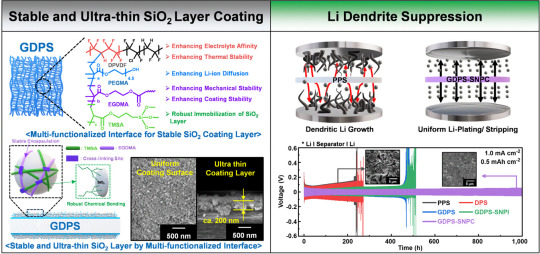
The separator between the anode and cathode of a lithium-ion battery poses a major engineering challenge. Separator failure leads to an internal short circuit, with potentially catastrophic results. But simply increasing the separator thickness reduces battery capacity and can impede the flow of ions that the battery needs to function. A group of Korean researchers thinks they've made progress, with a thin SiO2 coating for a polymer separator.
0 notes
Text
Energy storage materials are substances or systems capable of storing energy for later use. These materials play a crucial role in various applications, including renewable energy storage, portable electronics, electric vehicles, and grid stabilization. Several types of energy storage materials exist, each with unique properties and applications. Here are some common categories:
Visit : https://electronicmaterialsconference.com/
#EnergyStorage#BatteryTechnology#RenewableEnergyStorage#LithiumIon#Supercapacitors#HydrogenStorage#ThermalEnergyStorage#FlywheelTechnology#MaterialsScience#GridStorage#ElectrochemicalMaterials#EnergyInnovation#SustainableEnergy#GreenTech#SmartGrid#EnergyEfficiency#PowerStorage#AdvancedMaterials#CleanEnergy#EnergyTransition
0 notes
Text
0 notes
Text
Powering the Future: How Radical Electrification Can Fight Climate Change and Create Jobs
#batterytechnology #cleanenergy #climatechange #economicchallenges #electricvehiclechargingnetworks #electricvehicles #governmentpolicies #greenhousegasemissions #gridstability #infrastructureinvestment #privatesectorinvestments #Radicalelectrification #renewableenergysources
#Business#batterytechnology#cleanenergy#climatechange#economicchallenges#electricvehiclechargingnetworks#electricvehicles#governmentpolicies#greenhousegasemissions#gridstability#infrastructureinvestment#privatesectorinvestments#Radicalelectrification#renewableenergysources
0 notes
Text
Electric Vehicle Battery Market Solid Analyzed Segmentation, Demand, and Share Estimation by 2030

The qualitative report published by Exactitude Consultancy research on the “Electric Vehicle Battery Market offers an in-depth examination of the current trends, latest expansions, conditions, market size, various drivers, limitations, and key players along with their profile details. The Electric Vehicle Battery market report offers the historical data for 2018 to 2023 and also makes available the forecast data from the year 2024 to 2030 which is based on revenue. With the help of all this information research report helps the Market contributors to expand their market positions. With the benefit of all these explanations, this market research report recommends a business strategy for present market participants to strengthen their role in the market. This report analyzes the impact of the Covid 19 pandemic on the Electric Vehicle Battery Market from a Global and Regional perspective.
The global electric vehicle battery market is expected to grow at 21% CAGR from 2024 to 2030. It is expected to reach above USD 95 billion by 2030 from USD 17 billion in 2023.
For The Full Report Click here:
https://exactitudeconsultancy.com/reports/1879/electric-vehicle-battery-market/
#ElectricVehicleBattery#EVBattery#BatteryTechnology#BatteryMarket#ElectricVehicle#EVMarket#LithiumIonBattery#BatteryInnovation#BatterySupplyChain#BatteryManufacturing#EVIndustry#CleanEnergy#RenewableEnergy#SustainableMobility#FutureOfMobility#GreenTechnology#ElectricCars#EVCharging#BatteryManagementSystem
0 notes
Text
Starting batteries are not only necessary to start the engine, but also to power the electrical components during driving. 🔋
Discover the benefits of Leoch starting batteries:
① Excellent resistance to high and low temperatures
② Withstand frequent starting
③ Resistant to shock and vibration
④ Safe and environmentally friendly
Watch the video and then start your car with Leoch Battery!💨
Starting your journey with Leoch's powerful starting batteries. 🚗
#StartingBattery#HighEfficiency#ExcellentPerformance#EV#BatteryTechnology#LeochStartingBatteries#PowerfulStart#EngineStarting#ElectricalPower#HighLowTemperatureResistance#FrequentStarting#ShockVibrationResistance#SafeEnvironmentallyFriendly#CarBattery#LeochBattery
3 notes
·
View notes
Text
Powering the Future: The Train Battery Market
The global push towards sustainable transportation is driving significant growth in the train battery market. As countries around the world seek to reduce carbon emissions and combat climate change, electrification initiatives in the transportation sector are gaining momentum. Train batteries play a crucial role in powering electric trains, providing energy storage for propulsion and onboard systems.
One of the key drivers of the train battery market is the rapid urbanization and the increasing demand for efficient mass transit solutions. With cities becoming more crowded and congested, governments are investing in electrified rail networks to alleviate traffic congestion and reduce pollution. Electric trains powered by advanced batteries offer a clean and efficient mode of transportation, meeting the growing demand for sustainable mobility solutions.
Moreover, technological advancements in battery technology are driving innovation in the train battery market. Lithium-ion batteries, known for their high energy density and long cycle life, are increasingly being adopted for train electrification projects. These batteries offer improved performance and reliability, enabling electric trains to travel longer distances on a single charge.
In addition to passenger trains, train batteries are also gaining traction in the freight transportation sector. Electric freight trains powered by batteries offer lower operating costs and reduced environmental impact compared to diesel-powered locomotives. As a result, railway operators are increasingly investing in electrified freight corridors, driving the demand for train batteries.
Furthermore, government initiatives and policies promoting electrification are providing a significant impetus to the train battery market. Subsidies, tax incentives, and regulatory mandates are encouraging railway operators to transition to electric trains powered by batteries. Incentive programs aimed at reducing greenhouse gas emissions are further accelerating the adoption of electric trains, creating lucrative opportunities for manufacturers in the train battery market.
Looking ahead, the outlook for the train battery market is optimistic. As the global transportation industry continues to embrace electrification, the demand for advanced train batteries will continue to grow. Key market players are investing in research and development to develop more efficient and cost-effective battery solutions, driving innovation and propelling the growth of the train battery market.
#TrainBattery#RailwayElectrification#Transportation#Sustainability#EnergyStorage#ElectricTrains#RenewableEnergy#BatteryTechnology#Urbanization#MarketGrowth
0 notes
Text
💥 Discover the amazing process of welding positive and negative wires of a lithium battery pack 🔋✨ These remarkable sparks of innovation create the backbone of our modern technology. Join us as we delve into the fascinating world of battery manufacturing, uncovering the crucial steps that power our devices. Get ready for an electrifying journey! ⚡️
#lithiumbattery#lithiumbatterypack#lithiumbatteryfactory#lifepo4lithiumbattery#daxingpower#newenergy#batterymanufacturer#BatteryTechnology#powersupply#EnergyStorage#GreenEnergySolutions#EnergyStorageProducts
0 notes
Text

😎 John and Mike have run a golf course with a good reputation for 22 years. Both parties are determined to upgrade golf carts on the course with BSLBATT, the best battery on the market.
John: “Mike, have you seen the specs for the BSLBATT 48V 105AH LiFePO4 battery? It’s a game changer for our golf cart. With a whopping 4,000+ cycles, we can finally retire that crappy lead-acid battery. Plus, it It’s made from non-toxic materials, which is great for the environment.”
John: "That's right! That's another plus. These batteries feature fast charging, which means less downtime and more time on the course. The high discharge rate ensures consistent performance, even on those hilly terrains The same goes for above. More importantly, capital costs can be reduced by 80% in 5 years. Oh my God, I can’t wait.”
Click to get the perfect solution for you now: https://www.lithium-battery-factory.com/lifepo4-golf-cart-batteries/
0 notes
Text
Lithium: Deciphering Market Trends, Emerging Technologies, and the Impact on Global Energy Transition
The global lithium market size is expected to reach USD 18.99 billion by 2030, according to a new report by Grand View Research, Inc. The market is expected to grow at a CAGR of 12.8% from 2024 to 2030. Rising investments in lithium mining and related technologies are projected to remain a key trend in the market. Lithium mining is witnessing rapid growth as its demand is accelerating owing to its application in batteries. The element is found in dry places that require thousands of liters of water for its mining. Considering the rising demand for elements and increasing usage of water required for its extraction, R&D is in place to find better alternative methods. For instance, in February 2020, funding of around USD 20 million by Bill Gates was provided to Lilac Solutions, a lithium mining technology firm located in the U.S.

Lithium Market Report Highlights
In terms of revenue, the hydroxide product segment is projected to register the fastest CAGR from 2024 to 2030. The rapid development of battery technologies is projected to remain a key driver for the segment
Automotive was the largest application segment in 2023. The rising penetration of Electric Vehicles (EVs) along with stringent emission regulations by government bodies is the key focus area for market vendors
The consumer electronics segment is projected to witness the highest CAGR over the forecast period, in terms of revenue, due to the high demand for electronic products, such as smartphones, tablets, laptops, wearables, portable speakers, and tablets
Asia Pacific was the largest regional market in 2023, in terms of both volume and revenue. The growth of the region can be attributed to the heavy investments in lithium mining as well as lithium-ion battery technologies
In terms of volume, Europe accounted for the second-largest market share in 2023. The growth of the region is attributable to the rising penetration of EVs and growing concerns about Greenhouse Gas (GHG) emissions
For More Details or Sample Copy please visit link @: Lithium Market Report
According to the firm, its ion exchange technology is two times more efficient compared to the current mining process and requires a fraction of time. Lithium recycling is a complex process; however, with the rising penetration of Li-ion batteries, the demand may outpace supply. Therefore, researchers are focusing on extraction and recycling through various new technologies. Lithium compounds are extracted from batteries as per individual methods and stages. The stages are divided into pre-treatment and extraction stages; while extraction is again categorized into hydrometallurgy, pyrometallurgy, and electrochemical extraction. Despite the growing emphasis and development of different recycling technologies, less than 1% of lithium is recycled currently.
Over the last decade, the rise in usage of Li-ion battery storage has led to a decline in their prices by over 80%, leading to enhanced energy storage and paving the way for Electric Vehicles (EVs) to be commercially viable. Government regulations and subsidies are working on expanding clean energy; thus, energy storage systems represent a huge opportunity for investors. However, expensive raw materials required to produce energy storage systems may remain a critical factor for investors. As per the International Energy Agency, new companies in clean energy have attracted significant investments during the COVID-19 pandemic. Early-stage Venture Capital (VC) investments reduced slightly in the first half of 2020. However, these investments recovered quickly, with record investments from the third quarter of 2020.
#LithiumMarket#RenewableEnergy#BatteryTechnology#ElectricVehicles#EnergyStorage#Sustainability#ResourceInvesting#Mining#SupplyChain#MarketAnalysis
0 notes